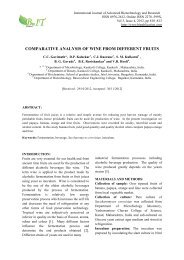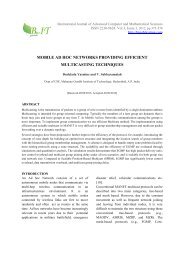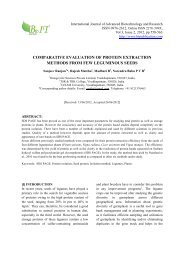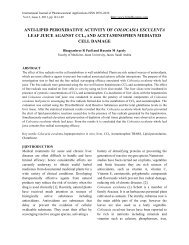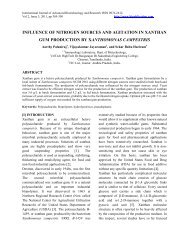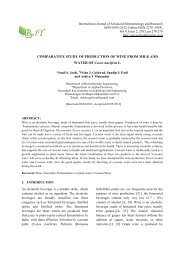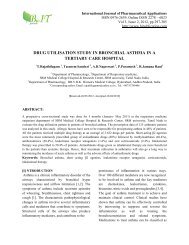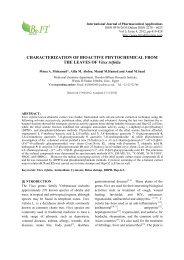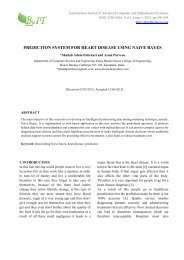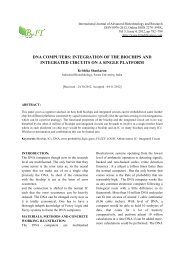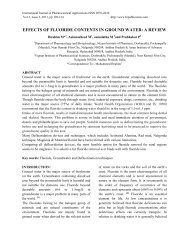431-436 - BioIT international Journals
431-436 - BioIT international Journals
431-436 - BioIT international Journals
You also want an ePaper? Increase the reach of your titles
YUMPU automatically turns print PDFs into web optimized ePapers that Google loves.
SOME ANGIOSPERMIC PARASITIC PLANT FROM NARNALA FORT<br />
help of flora of Maharashtra (MS) and flora<br />
of Marathwada (Naik 1986). The specimen<br />
vouchers of collected plants were deposited<br />
in Department of Botany, Shri Shivaji<br />
College Akola. The collected Ethnomedicinal<br />
information was thus interpreted in the light<br />
of recent researches and presented in this<br />
paper.<br />
Observations and Discussion:<br />
The present paper deals with Ethnomedicinal<br />
uses of 10 parasitic plant species from 5<br />
families. The botanical Name, family, parts<br />
use and disease on which the medicine is<br />
given, and modes of administration are given.<br />
Although above plants are common and<br />
ethnomedicinally investigated from various<br />
regions of Indian subcontinent, the present<br />
study is focused mostly on the view of<br />
ethnomedicines of tribal community which<br />
live in Narnala forest ranges. This area is<br />
lacking proper health care systems rendered<br />
by Government. During the investigation,<br />
authors have collected about several different<br />
plant species of which only 20 parasitic<br />
plants have presented here. The collected<br />
indigenous information is mostly found true<br />
and analogous to the reports of [2],<br />
[3].However, the present study needs further<br />
phytochemical investigation which might<br />
prove beneficial for improving the life style<br />
of Narnala fort tribal peoples and to enrich<br />
the basic researches leading modern<br />
medicinal biology. Plants have been used in<br />
traditional medicine for several thousand<br />
years [4]. Drugs obtained from plant are<br />
believed to be much safer and exhibit a<br />
remarkable efficacy in the treatment of<br />
various ailments [5]. Plants have always been<br />
the source of medicines and have many uses<br />
to mankind. According to some earlier<br />
workers [6-8].<br />
1. Cuscuta reflexa Roxb.<br />
Vernacular Name :. Amar-bel, Amar-vel.<br />
Family: Cuscutaceae<br />
Locality: Narnala Fort<br />
Habitat: Occasional on bushes.<br />
Description:<br />
Stem parasites with greenish-yellow, leafless,<br />
twining and hanging pale yellow, fleshy<br />
stems. Flowers white or creamy-white,<br />
solitary or in umbellate clusters in short<br />
racemes. Capsules globose 0.5-0.8 cm across,<br />
glabrous, circumsessile near the base.<br />
Ethnomedicinal uses:<br />
The decoction of seeds in high doses causes<br />
abortion. Plant paste is applied on swollen<br />
testicles (Banjara). Bhils take orally the<br />
decoction of stem (30 ml) to cure jaundice,<br />
urinary disorder and stomacache. Plant paste<br />
applied on the scalp to prevent hair<br />
fall.Andh: Tribals take orally the decoction<br />
of stem to cure diarrhoea, cholera and<br />
asthma, fever, cough and cold.<br />
2. Viscum verrocosum<br />
Family: LORANTHACEAE<br />
Vern. Name: Hadjod, Harjor.<br />
Locality : Narnala Fort<br />
Habitat : Obligate semi-parasite on<br />
Boswellia serrata Roxb. and on other trees.<br />
Description: dichotomously branched,<br />
pendulous; branches articulated, yellowish-<br />
Pranjali J. Deshmukh 432



